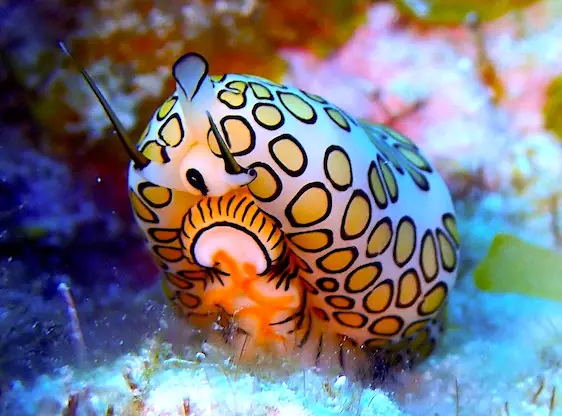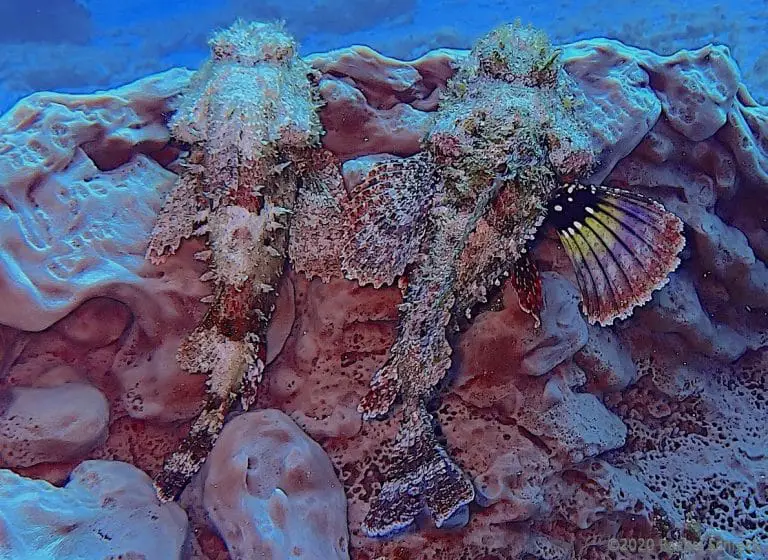Flamingo Tongue Sea Snails: My Cozumel Macro Photo Muse
The Sea Snail that Started it All
Many of my Cozumel scuba diving buddies tease me a bit about my borderline obsession with Flamingo Tongue sea snails (Cyphoma gibbosum).
They’re absolutely right. No matter how many underwater photos I’ve taken of them while diving in Cozumel, I always go back for more.
The first time I saw one of these gorgeous little critters, I fell in love.
I was in awe of their unique and dramatic markings, striking colors, and the odd curvy shape of their shells and bodies.
Back then, finding one was like finding a little hidden gem tucked into a vast, complex reef. It was my first taste of the underwater macro photo treasure hunt.
My enthusiasm for macro marine life, and eventually my love of underwater macro photography in Cozumel, started right there with the flamingo tongue sea snail.
Practice Underwater Photography in Cozumel
Starting out with an underwater camera can be frustrating.
Lots of overly blue frames, blurry fish, and “just missed” frames.
Flash forward many years, and now I frequently dive and take lots of underwater photos on the reefs of Cozumel, Mexico, where these marine gastropod mollusks are now quite plentiful.
Their numbers have rebounded, and these days you can very often find them on gorgonian corals like sea whips and purple fans.
Not only have my diving skills vastly improved since way back then, but the flamingo tongues’ flamboyance makes them a relatively easy creature to spot.
They don’t move quickly or get spooked away, either, so they are the perfect example of choosing easier subjects for underwater macro photography – especially if you’re just starting out.
For more tips and tricks if you’re just starting out with
So after shooting them for years, you might think I’m probably growing bored with them at this point, right? Not even a little.
I have thousands of images of flamingo tongues, and I can safely say no two are the same.
If I find one, I always have to look closer. Like with most marine animal subjects, now the fascination is about variation and behavior.
Flamingo Tongues – Variation and Behavior
At first, I’d notice their individual spots and coloration, the wide variety of sizes, new locations along the reef, and how each one’s flesh was exposed or retracted to differing degrees.
Over time I’ve photographed them on gorgonian corals (their most common habitat), but also on lacey purple sea fans, in and around barrel sponges, and even “strolling” across the open sand.
Alone, in pairs, or in big messy bunches.
Bigger thrills came later, when I started to find and document many of them mating or laying large, neat rows of translucent white eggs.
Coming full circle, I’ve also found and photographed many even tinier juvenile flamingo tongues (tic-tac size).
Flamingo Tongue Snails’ Life Cycle – Original Photos
The images included here show just a small sampling of the more common flamingo tongue (cyphoma gibbosum) life cycle:
Different Types of Allied Cowries in Cozumel
The bottom line is, as I grew more familiar with the anatomy and behaviors of this one species, I learned more about them and started to identify patterns.
And to quickly detect variations.
In the category (Allied Cowries – Ovulidae), there are variants to the Flamingo Tongue snail to be found here in the Caribbean – and not just their juvenile variety.
Fingerprint Cyphoma
One is similar in size and coloring, but has more of a lined pattern like a fingerprint – hence its name of Fingerprint Cyphoma (Cyphoma signatum) – far rarer to find in this area.
Another similar species resembles a juvenile FT, but a good look at it shows differences. Look closely, and you can see the distinctly different skin colors, shell shapes, and paler yellow spots that are outlined in a vibrant pink color.
Pink-Circled Simnia
I introduce the Pink-Circled Simnia.
This is a type of Cymbovula, referred to as “sp 3”, according to my best reference book, The Caribbean Reef Creature Identification book for Florida/Caribbean/Bahamas (Humann, DeLoach and Wilk).
Learn those critters!
Triangle Cyphoma
And finally, another that looks like a juvenile flamingo tongue, but much darker in color and with spots that nearly take up the whole mantle. This is familiarly identified as a Triangular Cyphoma in that same book, above.
As I searched for and found these variations, I got a greater sense of the behaviors and typical hiding places. I was in turn able to create more and more compelling images of them.
And that helped me, and other divers around me, understand what we were observing in much finer detail.
I think that’s the real beauty of
Underwater Macro Photography – the Treasure Hunt
That, and that the treasure hunt never ends.
The hunt for fresh finds and new Cozumel marine life behaviors is half the fun.
Every dive site in the Cozumel marine park offers the chance to see something new.
My favorite subject has taught me the same lesson I now slowly apply to other marine species, and just diving in general, which is: the more you look, the more you see.
You never know what amazing images you might be rewarded with if you’re patient.
Notice aberrations. Take another look. Capture something that goes way beyond a stock photo.
As you practice documenting the same species over and over, you’ll also find yourself playing with different lighting, angles, and compositions.
Over time, you’ll learn more, and also see your skills improving in no time.
Cozumel Macro – Tips for Beginner UW Photography in Cozumel
As a newbie underwater photographer, there are some key things to keep in mind when choosing these test subjects:
- Select something you find beautiful and interesting – even your early pictures will make you happy. Try to take repeat shots of species that are naturally more steady and big enough to find a good focus point
- Pick subjects that are in shallow water. Bonus points if you can find them during easy shore dives in Cozumel, so you can safely practice more easily
- Judge how shy or easily spooked the species is – you definitely don’t want to stress out our marine friends, and you also want to gain confidence in your hobby over time, not endless frustration
- If the notorious Cozumel current is strong on a given dive, don’t drive yourself mad trying to take macro photos. Fighting the current will make you go through your air too fast, and you’ll very likely touch and damage the very things you’re trying to honor. Just wait until the next day – there are plenty of FTs in this part of the world
- This one is the MOST IMPORTANT one: Make sure your diving skills are good enough before you introduce a camera into the mix. You don’t want to be the diver with a camera but poor buoyancy skills and no spatial awareness!
- If you need to touch the reef or use a hook or bump into the coral to get your image? DON’T DO IT. Practice your diving more, practice with photos of wider subjects, and have patience. As your diving skills improve and you’re free of any crutches, so will your photography skills.
For more insight and ideas on getting into
**All photos in this post were taken by yours truly with the easy-to-use but excellent TG-6 camera by Olympus. See the end of the post for a link to our full review and recommendations for a complete beginners’ UW photography setup. Perfect if you’re just starting out.
Flamingo Tongue Fan Girl – Guilty
For me, the flamingo tongue will forever have a special place in my heart. My first macro-crush and what led to my Cozumel
Send me your photos! I’d love to see them and add them to this post.
OK, now let’s go diving…
- Easy to use
- Easy to pack
- Easy on the wallet
- Durable, waterproof, dustproof













